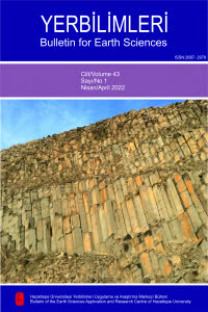Improvement of Environmental Conditions of Faryab Chromite Mine Using Backfill
xx
Improvement of Environmental Conditions of Faryab Chromite Mine Using Backfill
Binder agent, Chromite slag, Environmental conditions, Faryab Chromite mine, Green backfill Stope and Pillar,
___
- American society for testing and materials, 2000a. Standard Practice for Slump of Hydraulic - Cement Concrete. Designa- tion: C143/C 143M - 98, Annual Book of ASTM Standards, Sec. 4, Vol. 04.02, Concrete and Aggregates, Philadelphia (PA), pp. 88-90.
- American society for testing and materials, 2000b. Standard Practice for Making and Curing Concrete Test Specimens in the Labo- ratory. Designation: C192/C 192M - 98, Annual Book of ASTM Standards, Sec. 4, Vol. 04.02, Concrete and Aggregates, Philadelphia (PA), pp. 113-120.
- BS, 2000a. Testing hardened concrete-Part 1: Shape, dimensions and other require- ments for specimens and moulds, BS EN 12390-1.
- BS, 2000b. Testing hardened concrete-Part 2: Making and curing specimens for strength tests, BS EN 12390-2.
- BS, 2000c. Testing hardened concrete-Part 3: Compressive strength of test speci- mens, BS EN 12390-3.
- Benkendorff, P.N., 2006. Potential of Lead/Zinc Slag for use in Cemented Mine Backfill. Scopus Journals, Transaction of Insti- tution of Mining and Metallurgy, Secti- on C, Mineral Processing and Extracti- ve Metallurgy, Vol. 115, 171-173.
- Brown, E.T., 1981. Rock characterization tes- ting &monitoring, ISRM suggested met- hods. Pergamon Press.
- Bieniawski, Z.T., 1989. Engineering Rock Mass Classification, J.Willey, New York.
- Das B.M., 1983. Advanced soil mechanics. McGraw Hill Limited, New York.
- Dehghan, S., Shahriar, K., Maarefvand, P., and Goshtasbi, K., 2010. Calculation of pillar stress in room and rib pillar mine during the ore exploitation. Proceeding of 4th International conference on Mining in- novation, Santiago, Chile, 503-512.
- Dehghan, S., Shahriar, K., Maarefvand, P., and Goshtasbi, K., 2011. Analysis and Nu- merical Modeling of Cemented Backfill Pillars Behaviour in stope and pillar mi- ning method. PhD thesis, Mining Engi- neering Department, Science and Re- search Branch, Islamic Azad University, Poonak, Hesarak, Tehran, Iran (unpub- lished).
- DeSouza, E., Archibald, J., and Dirige, A., 2003. Economics and perspectives of underg- round backfill practices in Canadian mining. 105th Annual General Meeting of the Canadian Institute of Mining, Me- tallurgy and Petroleum. Montreal, CIM.
- Faryab Company, 2007. Technical report.
- Grice, A.G., 1989. Fill research at Mount Isa Mi- nes Limited. Innovations, Proc. Forth International Symposium on Mining with Backfill, F.P. Hassani, M.J. Scob- le and T.R. Yu Eds., A.A. Balkema (Rot- terdam), pp. 15-22.
- Hassani, F., and Archibald, J., 1998. Mine Back- fill. CIM Conference Proceedings, Ca- nadian Institute of Mining and Metal- lurgy, Montreal, Que.
- Khoek, S.C., 1981. Metallurgical Slag as Ce- menting in Underground Mine Filling. Proc. Of Asian Mining’81, Singapore, Malaysia, 285-291.
- Niemineh, P., and Seppanen, P., 1983. The use of blast-furnace slag and other by pro- ducts as binding agents in consolida- ted backfilling at Outokumpu Oy’s mi- nes. International Symposium on Mi- ning with Backfill, Lulea.
- Peila, D., Guardini, C., and Pelizza, S., 2008. Geomechanical Design of a Room and Rib Pillar. Granite Mine, Journal of Uni- versity of Science & Technology Beijing, Vol 15, No 2, 97-103.
- Petrolito, J., Anderson, R.M., and Pigdon, S.P., 2005. A review of Binder materials used in Stabilized Backfills. CIM Bulletin; 98,
- ; ProQuest Science Journals, 85.
- Sivakugan, N., Rankine, R.M., Rankine, K.J., and Rankine, K.S., 2006. Geotechni- cal considerations in mine backfilling in Australia. Journal of Cleaner Producti- on, 1168-1175.
- Thomas, E.G., and Cowling, R., 1978. Pozzola- nic Behavior of Ground Isa Mine Slag in Cemented Hydraulic Mine Fill at High Slag/Cement Ratios. Proc. of 12th Can. Rock Mechanics Symposium, 129-132.
- ISSN: 1301-2894
- Yayın Aralığı: 3
- Başlangıç: 1976
- Yayıncı: Hacettepe Üniversitesi Yerbilimleri Uygulama ve Araştırma Merkezi
Magma Odalı Yavaş Yayılan Okyanus Ortası Sırtlarda Isı Modellemesi
Doğa DÜŞÜNÜR-DOĞAN, Javier ESCARTIN
E. Yalçın ERSOY, Fulya DİNDİ, ÖZGÜR KARAOĞLU, Cahit HELVACI
Magma odalı yavaş yayılan okyanus ortası sırtlarda ısı modellemesi
Doğa DOĞAN DÜŞÜNÜR, JAVIER ESCARTIN
Bozüyük Civarının Adakit Benzeri Magmatik Kayaçları (KB Türkiye)
Improvement of Environmental Conditions of Faryab Chromite Mine Using Backfill
Saeed DEHGHAN, Koroush SHAHRIAR, Parviz MAAREFVAND, Kamran GHOSTASBI
